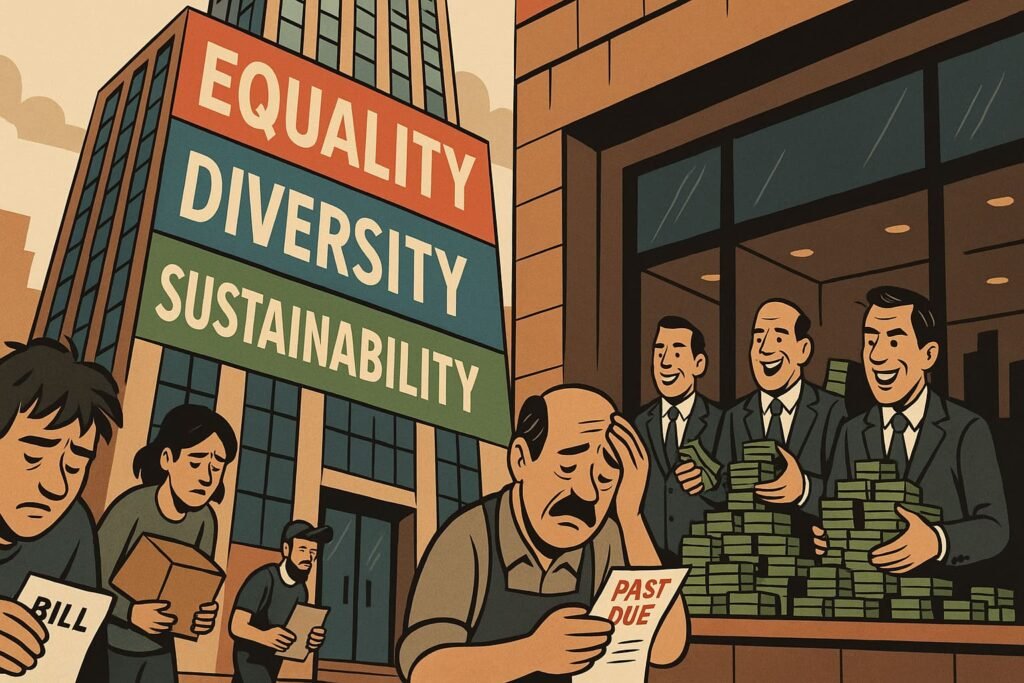Corporate Branding – Equity Pledges and Rainbow Logos as Cover
Corporate branding used to mean glossy adverts, catchy slogans, and a logo plastered everywhere. It was about selling products, not values. Today, that’s changed. Branding has moved from “buy our stuff” to “support our cause.”
Welcome to woke branding: the corporate strategy of wrapping products in social justice slogans. From rainbow logos to climate pledges, companies now market virtue as aggressively as they market toothpaste. The language is inclusion and fairness. The reality is a PR strategy that protects profits and distracts from real inequality.
Table of contents
From Image to Ideology
For decades, branding was about creating identity. Coca-Cola sold “happiness,” Nike sold “just do it,” Apple sold “think different.” But as culture wars heated up, corporations found a new identity to sell: moral superiority.
By adopting the language of activism, corporations look modern, caring, and progressive — all without changing their business models. Workers still earn the minimum. Supply chains still exploit. But the brand looks virtuous.
The Rise of Woke Branding
Woke branding is cheap compared to real reform.
- Painting a logo rainbow costs nothing.
- Hiring a “Chief Diversity Officer” is cheaper than raising wages.
- Running a climate ad campaign is easier than fixing polluting factories.
Symbolic gestures generate headlines, social media shares, and goodwill. Actual change? Optional.
Applications in the Real World
- Nike: Markets “empowerment” campaigns while outsourcing labor to low-wage factories.
- BP: Rebrands as “Beyond Petroleum” even as it pumps record volumes of oil.
- Banks: Fly rainbow flags for Pride while foreclosing on homes the next day.
- Tech giants: Issue equity pledges while dodging taxes through offshore loopholes.
Each case proves the same point: it’s easier to change the logo than to change the system.
Who Really Benefits?
Not the workers, not the consumers. The winners are:
- Corporations – they buy virtue on the cheap.
- Executives – they polish their image as “visionary leaders.”
- Politicians – they piggyback on corporate campaigns to look modern.
The losers are small businesses that can’t afford to play the same PR game — and the public, who mistake slogans for substance.
The Distraction Game
The clever part of woke branding is how it shifts focus away from class struggle. Instead of talking about wages, unions, or tax avoidance, debate revolves around identity campaigns. Consumers feel like buying a product is activism. Politicians praise companies for “leading the way.” Meanwhile, inequality deepens in the background.
Why It Matters
Branding isn’t just about selling anymore. It’s about controlling narratives. Corporations discovered that moral language buys loyalty as effectively as low prices. And because they dominate media space, their version of morality sets the tone for society.
When businesses dictate the culture, politics becomes little more than a marketing department.
Conclusion
Corporate branding has evolved into woke branding — virtue as a business strategy. It looks like progress but functions as distraction. Companies that exploit workers, dodge taxes, or damage the environment can launder their image with slogans about justice, equality, and inclusion.
The next time you see a rainbow logo or climate pledge in an advert, ask: is this change, or is it branding?
👉 For the bigger picture of how corporations gained their power, visit The Power of Business & Corporations Explainer Hub.
FAQ Section
What is corporate branding?
It’s the strategy companies use to build identity and loyalty, moving beyond products to values and causes.
What is woke branding?
A modern form of corporate branding where companies adopt social justice slogans and identity politics to market themselves.
Why do companies use woke branding?
Because it’s cheaper and safer than real reform. It boosts image while avoiding tougher issues like wages, taxes, or exploitation.
Who benefits from woke branding?
Corporations, executives, and politicians. The public gets slogans, but little real change.



